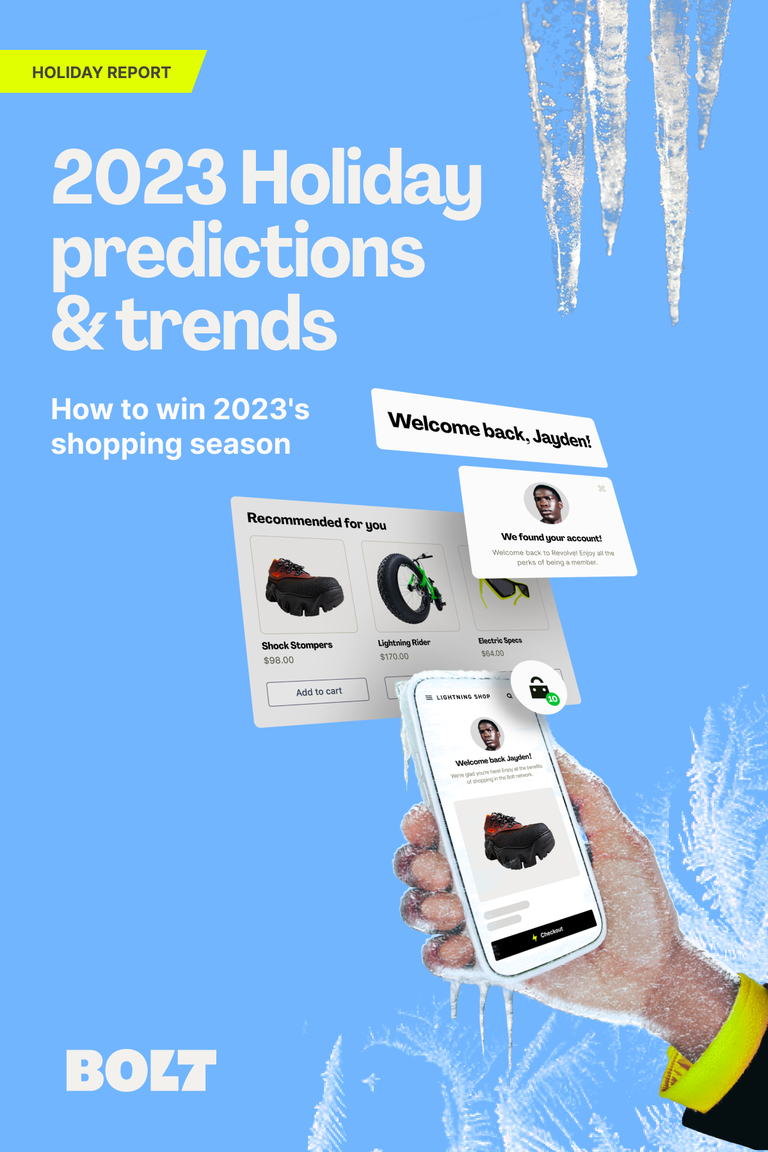
Retailers are seeking to avoid a repeat of last year after many instances of over-ordering merchandise resulted in heavy discounting in January.
Indeed, there are early warning signs for the holiday season ahead, with struggling retailers reporting disappointing sales. It is possible consumers, already picky about where they shop, will become even more selective. In Bolt’s August 2023 poll of more than 100 US e-commerce companies with over $5 million in online gross merchandise volume (GMV) from physical goods sales, more than 70 percent of retailers worry about decreased spending this season due to inflation.
Indeed, although last year’s holiday season was dominated by headlines about inflation and supply chain issues, US consumers spent $211.7 billion online over the 2022 holiday season from November 1 to December 31, according to Adobe Analytics, growing 3.5 percent year-over-year — a new peak in e-commerce sales.

But code freeze is nearing or already in place — the period when any technical changes to websites are halted — and with it, the last chance to optimise e-commerce experiences and indeed, the entire customer journey ahead of the holiday season. Retailers consequently need to consider now where to focus their efforts.
Bolt’s survey found that 66 percent of decision-makers are prioritising collecting customer data like email addresses and phone numbers in an effort to increase shopper accounts for on-going marketing efforts.
Through proprietary technology and a one-click checkout solution, Bolt integrates with retailers’ existing technologies, offering shopper recognition, account creation and one-click checkout. This frees up time for brands to focus on boosting sales while enabling personalisation at scale and building customer loyalty, especially through the busy holiday season.
Of the key issues in growing customer lifetime value (LTV), 51 percent of retailers say collecting and leveraging personalisation via first or zero-party data is most critical. Twenty-seven percent say attribution and technology issues around measuring LTV accurately is key, and 22 percent point to rising media costs as a barrier to building LTV.
Below, BoF shares excerpts from Bolt’s report, Countdown to Code Freeze, which includes proprietary survey findings as well as insights on retail trends to equip our community with actionable insights on preparing for the holiday period ahead.
Rising Acquisition Costs Place Emphasis on Repeat Customers
Bolt: According to CNBC, 40 percent of retailers cite labour costs as their main concern for the upcoming peak season, followed by 38 percent of retailers who are struggling with labour shortages. As stated, 71 percent of retailers are concerned the consumer will spend less money in response to inflation and the research shows two-thirds of shoppers say they’ll buy holiday items on sale, while half plan to buy fewer items overall.
Marketers are scrambling to make the most out of their budgets. Research from Gartner shows that 71 percent of chief marketing officers lack the budget to fully execute their strategy in 2023. However, it is increasing acquisition costs that are likely to transform retailer strategies most significantly.
The over-reliance on paid ads to bring new customers and allow them to cut corners with guest checkout has led to empty CRMs and a lack of customer information.
Social commerce platform Simplicity DX published findings of a 222 percent increase in customer acquisition costs in 2022. Data from SEO agency First Page Sage also shows an increase in 2023, putting the average e-commerce customer acquisition cost at $86. The depreciation of third-party cookies has made retailers realise they do not know their customers well enough — the over-reliance on paid ads to bring new customers and allow them to cut corners with guest checkout has led to empty CRMs and a lack of customer information. This has put a renewed focus on e-commerce profitability and repeat sales.
However, despite all concerns related to inflation and reduced discretionary spending last year, the pandemic-fuelled surge of retail sales continued when holiday season retail sales grew by 4.8 percent year on year. This year, market researchers Insider Intelligence expects a similar gain of 4.5 percent for the 2023 holiday season. When it comes to US retail e-commerce sales, Insider Intelligence expects 8.5 percent growth for apparel and accessories and 18.4 percent for health, personal care and beauty.
Speed of Delivery & Return Policies Are Critical to Conversion
Bolt: Fast delivery is a vital component of successful e-commerce delivery. The Ipsos-Octopia study shows that delivery time is one of the most important factors for online shoppers. Moreover, 85 percent of them say they always check it before making a purchase.
In addition to delivery considerations, returns policies are now a key battleground in converting consumers. While overall return rates are declining, the 2022 holiday season saw a bump in e-commerce returns. During the last peak season, 13 percent of orders were returned in November and December, according to Salesforce data, which represents a 63 percent increase over 2021. For many customers, not offering free returns can be a deal breaker.
Data shows that 78 percent of shoppers would abandon a shopping cart if free returns weren’t available. What’s more, 93 percent of shoppers research a brand’s return policy before making a purchase. Salesforce predicts that poor returns experiences, policies and processes will put 21 percent of online orders at risk.
Retailers Brace for Another Season of Consumer Discount Hunting
Bolt: Last holiday season, many businesses, especially big-box retailers such as Target and Walmart, revealed huge inventory builds leading to a period of hefty discounts. There’s no doubt that discounts were the main sales driver. However, many retailers are still drawing down inventories, so we can expect a discount-heavy season once again. According to CNBC, roughly two-thirds of retailers expect consumers to look for discounts. This could be a great opportunity for retailers with bloated inventory who can offer discounts to hook customers and clear out unsold stock.
Black Friday was the busiest day of the holiday season on the Bolt platform, but findings show that across 2022, Mondays were peak holiday shopping days, outperforming weekends.
Cyber Monday continues to be the US holiday season’s biggest online shopping day, with 5.6 percent year-on-year growth in 2022. During the “Cyber Five”, the five days spanning Thanksgiving to Cyber Monday, the average cart size was 3.2 items per order, the same as in 2021. GMV increased by around 2 percent and average order value (AOV) increased by 15 percent from 2021.
Paid search remained the biggest driver of sales for retailers, with 29 percent of online sales attributed to that channel, followed by direct web visits at 19 percent, organic search at 17 percent, affiliates and partners at 16 percent and email at 15 percent, as reported by Insider Intelligence. Black Friday was the busiest day of the holiday season on the Bolt platform, but findings show that across 2022, Mondays were peak holiday shopping days, outperforming weekends.
Immersive Social Experiences Continue to Grow in Popularity
Bolt: There’s no way around it — social media has become an integral part of customers’ shopping and purchasing journey. Data from McKinsey & Co. shows that social media is influencing the majority of US consumers’ holiday buying decisions and inspires more than 80 percent of younger consumers.
Consumers are using new technologies to virtually try on clothes, visualise furniture in their homes and even shop with interactive assistance. More than 90 percent of Americans currently use or would consider using augmented reality (AR) for shopping, according to Google.
In the past, the biggest roadblock to the widespread adoption of AR was the need to download an app to get the AR experience. This is now a thing of the past. Technology advancements have increased the immersive nature of AR experiences, and made them more accessible. Consumers can enjoy web-native AR experiences on the go, using just their phone’s camera. In fact, 43 percent of Americans would rather shade-match using AR at home than doing so in-store.
Google’s research shows that 43 percent of smartphone users expect all beauty brands to use AR. The “try before buy” experience helps online shoppers overcome the uncertainty of making a purchase, thus closing the online-offline gap.
Read Bolt’s Countdown to Code Freeze report to discover further insights on: personalisation, loyalty programmes, mobile-first experiences, BOPIS and seamless checkout experiences.
This is a sponsored feature paid for by Bolt as part of a BoF partnership.






